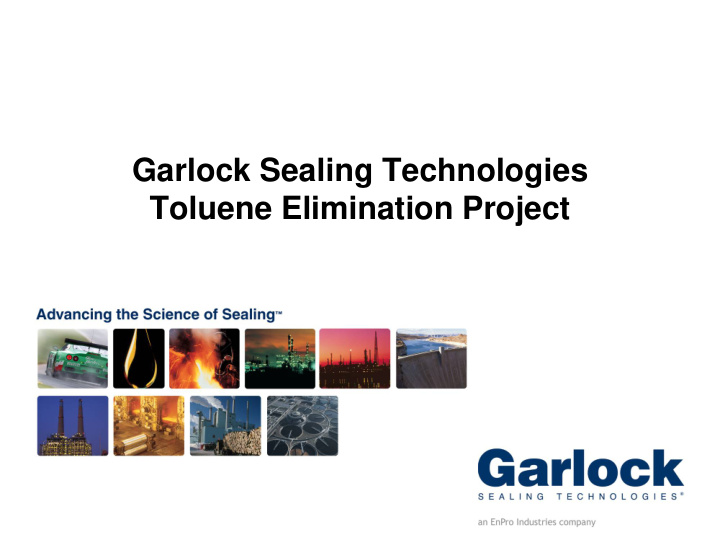



Garlock Sealing Technologies Toluene Elimination Project
Overview • Garlock had manufactured compressed sheet gasket (High Pressure Sheet) material using toluene since the product inception around 1905. • Average toluene emissions: 119 tons per year. • Parent company EnPro Industries’ and Garlock’s 2003 decision: eliminate toluene in manufacturing processes • Garlock implemented project resulting in elimination of 100% of toluene emissions from High Pressure Sheet manufacturing process, and discontinued use of toluene as of November 2007. – Voluntary action on Garlock’s part 2
Identifying an Alternative • Team formed in 2003 to identify alternative methods of production • Team researched and tested dozens of possible alternatives • New solvent identified as a possible non-VOC, non-HAP replacement for toluene • Decision was made based on significant testing that the new non-VOC solvent was a viable replacement for toluene: mid-2005 • First use of this solvent as an industrial processing aid in the rubber and plastics industries—substantial risk 3
Properties of Toluene vs. New Solvent • Decision to pursue the new solvent based on the following properties: Toluene New Solvent Volatile Organic Compound YES NO Listed as EPA YES NO Hazardous Air Pollutant (HAP) ACGIH Exposure limit 50 ppm 200 ppm California Proposition 65 YES NO listed chemical Listed as IARC Group 3 Carcinogen YES NO 4
Verification and Trials • Production trials began in early 2006 • New solvent verified as capable for High Pressure Sheet production • Production trials (entire product line) completed May 2007 • Testing, verifying performance of material produced with New Solvent vs. Garlock specifications, completed August 2007 5
New Solvent Recovery and Re-use • Garlock also wanted to identify a method to recover the new solvent’s emissions and recycle the product back into the process. • Garlock worked with outside vendors to develop a method to retrofit its existing carbon adsorption systems. • Three-step process: – Solvent-laden air deposits solvent on carbon adsorption bed – Steam passes through, removing new solvent from carbon – Steam condensed, resulting in a water/solvent mixture that must be separated 6
New Solvent Recovery and Re-use • New solvent is nearly completely soluble in water • Significant effort to develop correct technology to remove the new solvent from water once vapor is condensed • Working with outside vendors, process developed to separate the new solvent and water • First system came on-line in December 2007 and has shown 93-97% recovery efficiency 7
8 Note hoods and solvent recovery lines near ceiling. HPS Process
Investment in the Future • Decision to pursue elimination of toluene based strictly on environmental stewardship and more healthful working conditions for employees • Projects costs exceed $3 million • Payback approximately 10 years (2020) • Garlock confident that eliminating toluene will pay back in many unforeseen ways in the future 9
Unforeseen Benefits of Project • Product actually processes better using the new solvent, generating less scrap • Potential that the new solvent will allow us to produce new styles using elastomers that could not be processed with toluene – Patent pending • New product line is “best in class.” 10
Unforeseen Benefits of Project The new toluene free product (Garlock Extreme) has 20% improved sealing ability (reduced emissions) than toluene equivalents. Sealability Comparison 24.5 108.3 19.6 51.3 18.9 17.7 20 ASTM F-37 N2 15 ASTM F-37 Fuel A L e a k r a te 8.6 10 DIN 3535 3.6 5 0.5 0.6 0.3 0.1 0 Garlock Extreme Competitive Carbon Competitive Graphite Competitive Carbon/Graphites Fiber Aramid Composition Vermiculite Note: Test samples (1/16” thick). N2 testing at 3000 psi load, 30 psi internal pressure. Fuel A testing at 500 psi load, 9.8 psi internal pressure. DIN 3535 testing at 4,640 psi load, 580 psi internal pressure (N2). Vermiculite sheet tested on 5/9/2007, all other sheets tested on 4/20/2007. Sales use only 11
Results of Project • Elimination of 100% of VOC emissions from High Pressure Sheet manufacturing process • Elimination of 100% of HAP emissions from High Pressure Sheet manufacturing process • More Healthful working environment for employees – Elimination of respiratory protection in the area due to increased ventilation and change in material. – Decreased incidents of fire – Elimination of a known carcinogen and narcotic like material 12
What’s in The Future? • Going global! – Facility in Mexico City – Other subsidiaries of parent company, En Pro • Stemco, Longview, Texas – completed 2011 – 100% elimination of Toluene and MEK from leather impregnation process. 13
Questions or Comments? Thank you! Jon Neubauer Garlock Sealing Technologies Sr. EHS Specialist Jonathan.Neubauer@Garlock.com (315) 597-3120 14
Recommend
More recommend